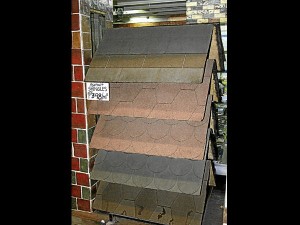
ROOF shingles come in various designs and patterns available at Pars Builders at Ortigas Home Depot. Photo by Alvin Uy
The roof isn’t just a structure over our heads but it’s also known as the “spine,” or the backbone of the structure – the one that protects or shields the home’s “vital organs.”
Sharing with Inquirer Property the pros and cons of different roof types in the Philippines are Edilberto J. Morcilla, past president of the United Architects of the Philippines Sampaloc chapter (and now president of Rotary Club Las Piñas Camino Real); Home Depot marketing manager Alvin Uy; and forensic architect Froilan L. Hong, FUAP, FPIEP, Apec architect, and outstanding environmental planner of 2007 by the Professional Regulation Commission. A forensic architect such as Hong is a professional consultant who studies every stage of a building’s life cycle, from concept and construction to the end of its useful life.
Several roofing materials available locally are the pre-painted long-span metal roofing, corrugated GI (galvanized iron) sheets, clay or ceramic roof tiles, fiber cement shingles, asphalt and wood shingles. Morcilla says some buildings necessitate the use of another material, the concrete roof deck.
The most commonly used roofing material by rank and type of application would be the unpainted corrugated G.I. roofing for the low-end market, which Morcilla says, is the cheapest but would also corrode and deteriorate the fastest if not painted properly.
“Once corrosion sets in, it is very difficult to stop the deterioration, and the best way to arrest the problem is to replace the whole sheet,” Morcilla says.
However, according to Uy, GI roof sheets are economical and practical. “There are GI sheet roofs that are stamped and molded to look like clay roofs and are already available in terra cotta colors to resemble clay roofs.”
Most economical
Uy adds that GI sheet roofs are the most economical in terms of cost per square meter, and the required support structure is also most economical. It is the easiest to patch up, as well, since these can be easily performed by a homeowner.
STONE 2000 offers a special skylite roof tile that allows sunlight to permeate the roof. Photo by Alvin Uy
“Under extreme situations where the the GI roof has been rusted through and through and looks like cheddar cheese, one can choose to hire a professional company to apply a material called ‘roof foam.’” Uy explains that this is sprayed on and leaves a 1.5-inch thick layer of waterproofed, insulated hard foam-in-place. This shield also has excellent acoustic properties that during heavy rains would not create too much noise (this is also called drumproofing).
For his part, Hong says pre-painted longspan metal roofing is practical and economical. “Less joints mean less chances of leaks,” he says.
Morcilla says prepainted long-span metal roofing is chosen by mid- to mid-upper class markets, and able to better resist corrosion. “Some suppliers even warrant their prepainted products up to 15 years against corrosion. They also perform better against leaks, being cut according to the length required, thus avoiding horizontal overlapping, which is one of the causes of leaks. They are also installed using a special type of screw called the ‘tekscrew’ with rubber washer, which is water tight,” he explains.
Morcilla says it would be better to use long-span metal roofing than commercial-length roofing sheets to eliminate overlapping joints and minimize the potential for leaks. Hong agrees, stating that long-span sheets cover more area, requiring less joints. Both ordinary and long span sheets are readily available in the market.
He explains that in the Philippines, prepainted long-span metal roofing made of GI sheets are the most preferred. Other metals such as aluminum, tin, and copper can also be used to produce prepainted long-span roofing sheets, albeit more expensively.
Hong adds that being prepainted, the GI sheets are already factory-painted (and usually coated with zinc-aluminum to make it more durable and rust resistant).
“GI roofing sheets is what is referred to when the term ‘bubong na yero’ is used,” he observes.
Elegant but impractical
SPANISH ceramic roof tiles can be made to look old and finished with a realistic patina. Photo by Alvin Uy
Clay or ceramic roof tiles and shingles cater to the high-end market. They look elegant but are “very heavy and require metal under sheeting and battens to keep them in place. They seldom pose a leaking problem, but when they do, it would be a big task to resolve,” Morcilla says.
The concrete roof deck is one of the most difficult types of roof to maintain and to repair when leaking sets in. “Even the most expensive type of waterproofing could fail at the slightest mistake during application. Sometimes, it takes redoing the whole deck area just to solve a small leak, because it is so difficult to find the source of the leak in the concrete,” Morcilla explains.
Hong advises homeowners to avoid using asphalt shingles as their roofing material because these capture and conduct the heat toward the inside of the house.
For more inquiries or advice, e-mail architect Morcilla at bullet2859@yahoo.com.ph, Home Depot at alvin.uy@cwhomedepot.com or F.L. Hong Architects & Associates at flhongaa@yahoo.com.